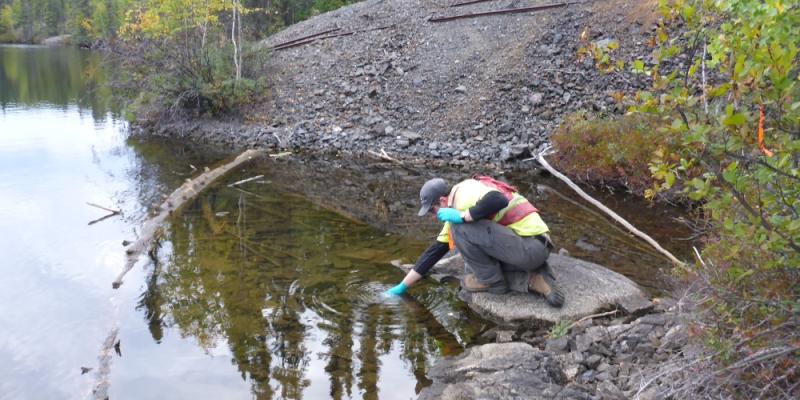Thirty-five abandoned uranium mine and exploration sites are located around the Uranium City area. Ore was not processed at these mines, but was shipped to the uranium mills at Lorado and Eldorado. Because there are no tailings present, these mines are called satellite mines. The Canadian Nuclear Safety Committee does not require licensing of these sites because of their low nuclear inventory. However, the sites do pose public safety hazards and in some cases, have potential impacts on the environment.
In May 2021, the Satellite Sites project team submitted two remediation reports to the Ministry of Environment, a significant project milestone. These deliverables summarize the remediation activities completed at the legacy uranium mine sites. Out of 35 legacy uranium mines, 20 mines have now been remediated.
Remediation work will be ongoing at these sites for many years. This includes backfilling adits and deep trenches; sealing shafts, raises and other openings to the underground; demolishing buildings; cleaning up mining debris; and burying non-hazardous waste in waste rock. Hazardous materials will be shipped to licensed landfills. Radiation is measured at the sites, and risk mitigation measures are implemented whenever necessary to protect the public (e.g., covering the elevated radiation areas with clean soil). Unstable slopes are being re-contoured. The long-term stability of the underground area is assessed and access is restricted to ensure public safety.
The work season in northern Saskatchewan is short: from late May until mid-October. The remediation work can only be done when snow does not cover the mine openings and debris. Mobilization of materials to Uranium City is generally by ice road in late winter. Access to some sites is difficult over land or by water.

Completed bat-friendly stainless steel cap permanently closing the mine shaft at the former Meta Umisk Uranium Mine Site.
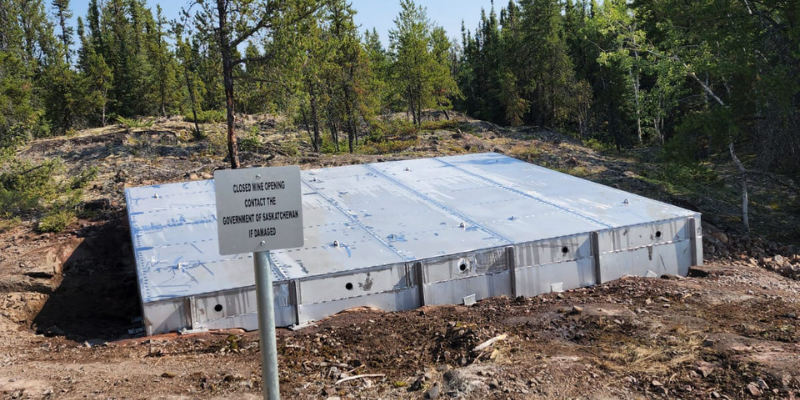
Completed stainless steel cap permanently covering mine shaft at the former Jesko Uranium Mine Site.

Stope breakthrough, Nicholson Mine
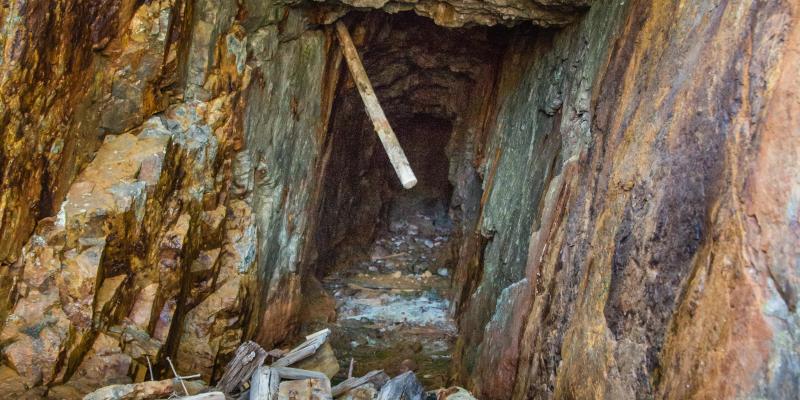
Upper Adit, Nicholson Mine
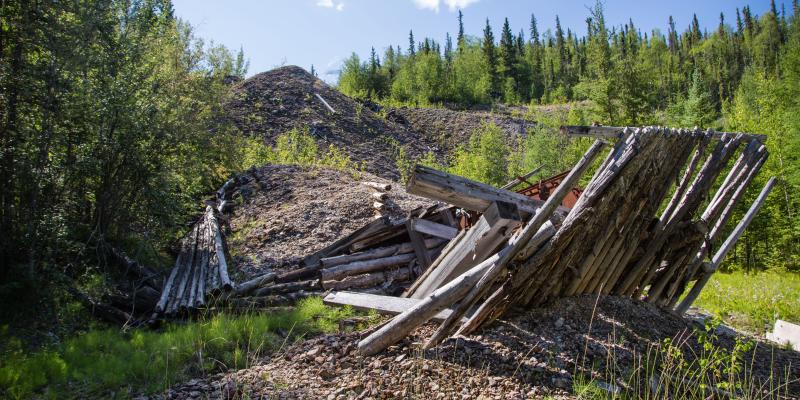
Debris and waste rock, Nicholson Mine
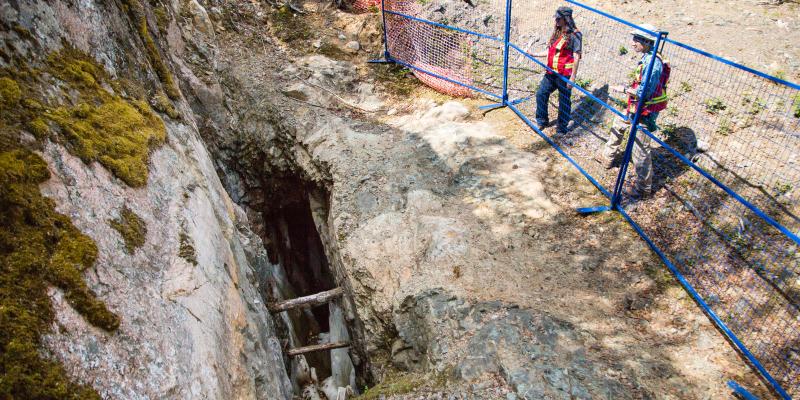
Stope breakthrough (to be covered), Rix-Athabasca, Leonard Mine
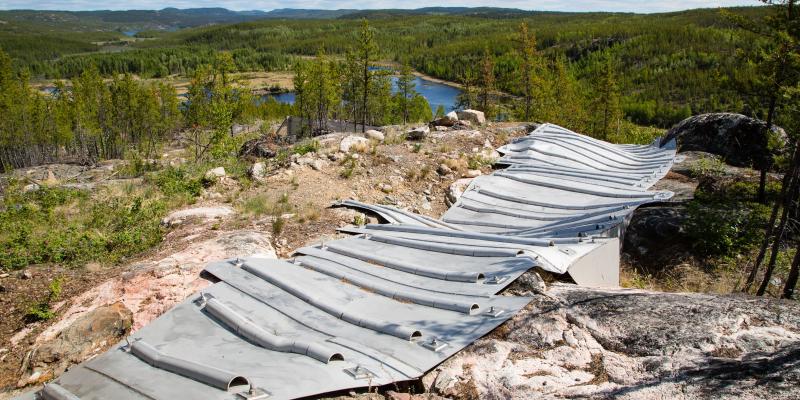
Stainless steel cap covering stope breakthrough, Rix-Athabasca, Leonard Mine
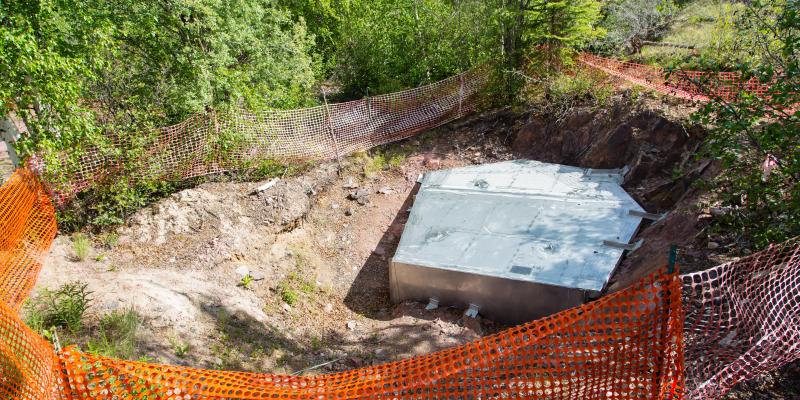
Stainless steel cap covering raise, Cinch/Cenex Mine

The former Cinch Mine site during transitional monitoring in 2022.
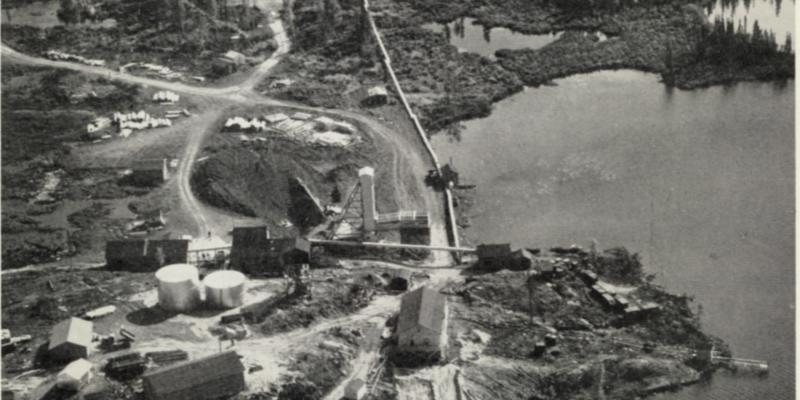
Cayzor Mine on Jean Lake in 1960.
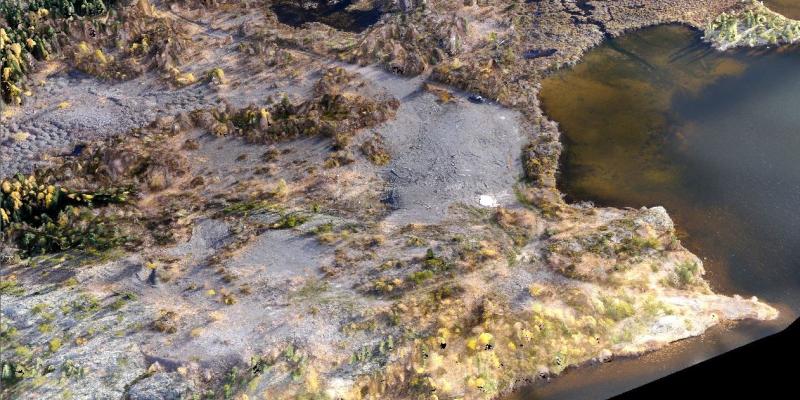
Cayzor Mine after remediation work in 2013.
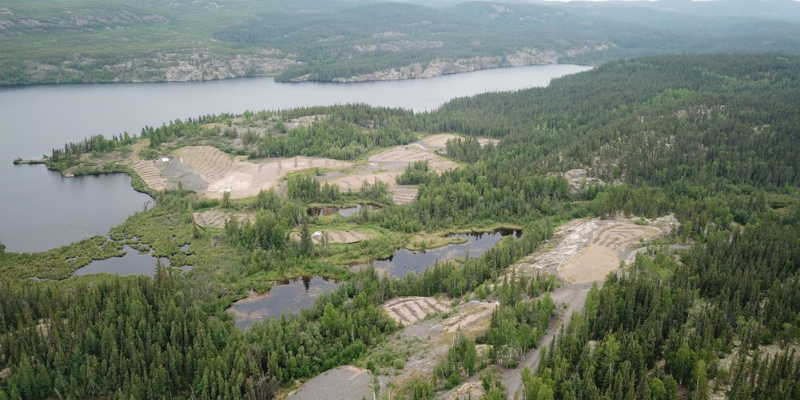
The former Cayzor Mine site during transitional monitoring in 2022.
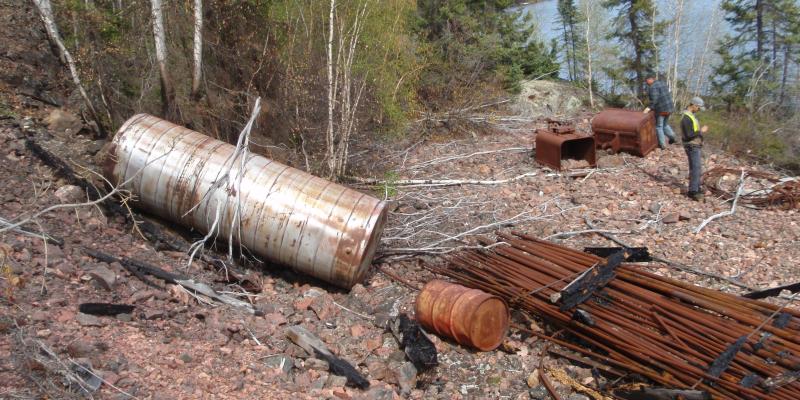
Mining debris scattered adjacent to the Baska Dot Claim mine by Virgin Lake, Sask.
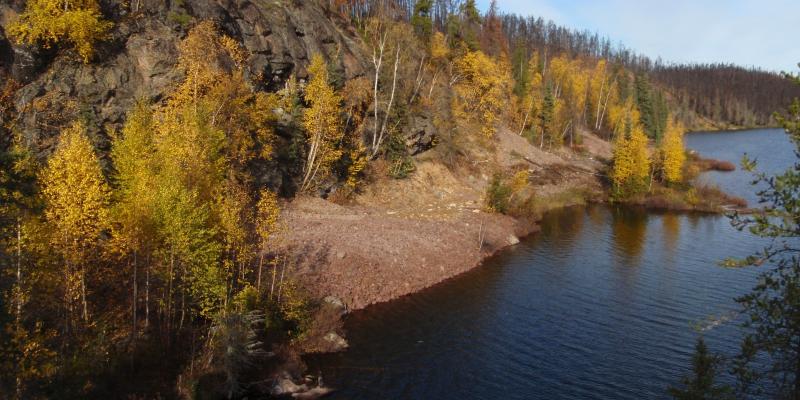
View of the Virgin Lake shoreline adjacent to the Baska Dot Claim mine after remediation work was completed.
The Satellite Sites team had an active 2022 field season with remediation completed at two sites: Jesko and Meta Uranium Mines. This involved closing the mine shafts at both sites, burying/removing historical site debris and mitigating gamma hot spots.
Underground assessments, pre-remediation gamma surveys, environmental sampling, wildlife and vegetation surveys took place at seven remote Satellite Sites. Two sites are accessible by boat, on the shores of Lake Athabasca (Tena Claim) and Beaverlodge Lake (Murmac). Five sites are accessible by float plane: Caba and New Mylamaque (Tazin Lake), Territorial (Coe Lake), Pitch Ore (Augier Lake) and Don Henry (Gatzke Lake).
Transitional monitoring, radiation surveys, sampling and assessments were completed at multiple sites, and will continue at other select sites next field season. The risk assessment and study of local wetlands at Lorado Mine, Uranium Ridge and Rix-Athabasca Smitty Mine was also finished.
SRC has completed remediation at 20 sites, with varying levels of assessment for the remaining 15 sites. Of the 20 completed sites, five sites have received the Ministry of Environment’s Release from Decommissioning and Reclamation, and four have been transferred to the provincial Institutional Control Program.
Activities during winter 2021 consisted of reporting on the previous field season activities, design and fabrication of stainless-steel closures, shipping of supplies over the ice road, regulatory application, and preparation for the upcoming field season. Reports on the completion of remediation at Strike Lake Uranium Mine and National Exploration Uranium Mine – Pat Claims were submitted to the Ministry of Environment. We have also initiated risk assessments and other studies at Lorado, Rix-Smitty and Uranium Ridge Mines.
In 2021, the following remediation work is planned: closure of 11 mine openings; investigation of mine openings and design of closures; continued Phase 2 site assessment of Nicholson Mine; transitional monitoring of select sites; vegetation, wildlife and archeological surveys; debris and hazardous materials management; addressing small areas with elevated radiation at select sites; treatment of hydrocarbon-impacted soil; and maintenance of public safety features. By the end of the season, remediation should be complete at Nesbitt Labine ABC Mine
In spring 2020, SRC reported to the Ministry of Environment on the completed remediation at four legacy uranium mines: Cayzor, Cinch/Cenex, Nesbitt Labine Eagle and Rix-Athabasca Leonard. The four sites are now in a period of transitional monitoring to demonstrate they are safe and stable before they are transferred to the Government of Saskatchewan's Institutional Control Program.
The 2020 field season had a delayed started due to COVID-19, but a lot was accomplished in the shortened field season. Remediation was completed at Gulch Mine, which included closure of the adit with a stainless-steel grate, collection and burial of non-hazardous debris onsite, removal of hazardous waste from the site and other work.
Radiation surveys were completed at National Exploration Mine-Pat Claims, Strike Lake Mine and Gulch. The data collected will allow reporting on the completed remediation of the three sites. Radiation surveys were also carried out at select sites to support remediation plan development. Several mine openings were inspected and surveyed to support the design of closures to be installed during the 2021 field season. The site assessment for Nicholson Mine was initiated and consisted of sampling of soil, waste rock and water, test pitting, survey, hazardous materials assessment, and investigation of mine openings and bedrock quality.
Remediation activities were successfully completed in the 2019 field season at the following abandoned uranium mines near Uranium City: Cayzor, Cinch/Cenex, Nesbitt Labine Eagle, Rix Athasbasca Leonard and Strike Lake.
The sites will be monitored in future years to ensure physical and environmental stability. Learn about SRC’s approach to closing abandoned mine openings in: https://src.nu/mineopenings.
During the winter of 2020, SRC released a Request for Proposals to select a consulting team for the Phase 2 assessment of Nicholson Mine. Phase 2 includes assessing underground hazards, environmental site conditions and hazardous material at the mine.
Reporting on the Phase 2 assessment of Lorado Mine and Uranium Ridge, and an additional environmental site assessment at Rix-Smitty, is currently being finalized. This work will be followed by the selection and design of remediation plans for the sites.
Remediation of the 35 Satellite Sites continued in 2018. Activities were prioritized at seven sites to support future remediation work at the sites: Cayzor, Cinch/Cenex, Nesbitt Labine ABC, Nesbitt Labine Eagle, National Exploration Pat Claims, Rix Athabasca Leonard and Rix Athabasca Smitty.
Work during the 2018 field season included collecting field data, continuing the environmental monitoring program, gamma surveys, collecting debris and hazardous material, designing closure methods for nine openings, preparatory work for the installation of fences around potentially hazardous underground areas and gamma soil covers, and continuing the site assessment of the Lorado Mine and Uranium Ridge Mine.
In May 2018, SRC visited two sites in La Ronge Provincial Park for the first time to install temporary safety measures and collect preliminary site data.
SRC has now visited all 35 Satellite Sites and installed temporary public safety measures around all known mine openings.
Work continued at several of the 35 Satellite Sites this past field season, including installing six stainless-steel caps (shipped via the ice road this past winter), implementing an innovative boulder closure as a new closure method at one Satellite Site, ongoing site underground mine working risk assessments and initiating new site investigations. Environmental assessments progressed at several sites, and a successful water sampling program was completed.
Wildlife and vegetation surveys were carried out in advance of any disturbance to the areas to ensure protection of wildlife and vegetation from any stress during remediation work. In addition, a post-impact heritage survey by an archeologist was conducted at selected sites where ground was disturbed during this season’s remediation activities.
SRC successfully visited five remote Satellite Sites in the Athabasca region, where historical uranium mining and exploration activities took place. Current assessments of these sites are now in progress.
- Assessment and Design
- Continued assessment of the risks associated with underground workings at four sites: Rix-Leonard, Rix-Smitty, Cinch/Cenex and Cayzor
- Initiated Phase 2 site assessment of the Lorado Mine and Uranium Ridge Mine
- Desktop review and field visit to assess the environmental condition of four sites: Cayzor, Cinch/Cenex, National Exploration - Pat Claim, Rix-Leonard and Nesbitt Labine-Eagle
- Survey and design of stainless steel closures for seven mine openings at three sites: National Exploration - Pat Claim, Rix-Leonard and Nesbitt Labine-Eagle
- Gamma radiation surveys at selected sites
- Continued environmental sampling and monitoring program at selected sites
- Remediation
- Remediation was completed at two sites: Beta Gamma - Bellegrade Lk and Pitch Ore - Beaverlodge Lk
- Initiated the remediation of Rix-Smitty Zone 62
- Garbage sweeps of entire site boundaries at 14 sites
- Initiated the treatment of fuel-contaminated soil at Rix-Smitty mine
- Maintenance of public safety measures
- Community Engagement and Capacity Building
- Held community meetings in the Athabasca Basin
- Mentored three students as part of SRC's Aboriginal Mentorship Program
- Land-use survey conducted in Fond du Lac Denesuline First Nation by Yutthe Nene, a local consulting firm
- Employed local guides
- Held a community BBQ in Uranium City
- Other Activities
- Definition and regulatory approval of site boundaries for all Satellite Sites
- Submitted reports to Saskatchewan Ministry of Environment for seven sites where remediation is complete. The next and final step for these sites is their transfer to the Institutional Control Program upon approval by the MOE. This Program, managed by the Ministry of Economy, monitors and maintains decommissioned and remediated mine sites over the long term.
- Installed two stainless steel caps on raises. This Canadian Mining Journal article describes this novel closure method for mine openings.
- Reviewed historical information to gain a detailed understanding of the mines. The information is used to create 2-D maps and interactive 3-D models of the underground mines.
- Detailed assessment of the stability of the underground mine workings at Rix-Athabasca Leonard and Smitty mines.
- Qualified 15 consulting firms through competitive bid process to provide engineering and science services in support of the Satellite Sites Program.
- Phase 1 site assessment of Lorado Mine and Uranium Ridge Mine.
- Detailed post-remediation radiation surveys and radiation risk assessment.
- Continued environmental monitoring program.
- Door-to-door consultation on land use of the Project CLEANS sites in Uranium City. Sixty percent of households were interviewed.
- Risk assessment, remediation, temporary safety measures and monitoring at those sites where work commenced in previous years
- Five mine openings were fitted with permanent closures
The following sites were included in the remediation work:
-
Lorado Uranium Mines Limited
-
Meta Uranium Mines Ltd.
-
Consolidated Nicholson Mines Ltd.
-
Consolidated Beta Gamma Mines Ltd., Tena Claim
-
Gulch Mines Ltd.
-
Jesko Uranium Mines Ltd.
-
Nesbitt Mining and Exploration Ltd., Reed Bay
-
Black Bay Uranium Mines Ltd., Murmac Bay
The following sites were included in the remediation work:
- Amax Athabasca Uranium Mines Ltd., Site 1 mine site
- Amax Athabasca Uranium Mines Ltd., Site 2 mine site
- Amax Athabasca Uranium Mines Ltd., Site 3 mine site
- Rix-Athabasca Uranium Mines Ltd., Leonard mine site
- Rix-Athabasca Uranium Mines Ltd., Smitty mine site
- Rix-Athabasca Uranium Mines Ltd., No.10 adit site
- Beta Gamma Mines Ltd., mine site
- Cayzor Athabasca Mines Ltd., mine site
- St. Michael Mines Ltd., mine site
- Baska Uranium Mines Ltd., Dot Claim mine site
- Beaverlodge - Mickey Lake mine site
- National Explorations Ltd., Keiller Adit site
- National Explorations Ltd., Pat Claim mine and camp sites
- Lake Cinch/Cenex Ltd., mine site
- Pitch-Ore Uranium Mines Ltd., Beaverlodge site
- Nesbitt LaBine Uranium Mines Ltd., Eagle sites
- Nesbitt LaBine Uranium Mines Ltd., ABC mine site
- Uranium Ridges Mines Ltd., mine site
